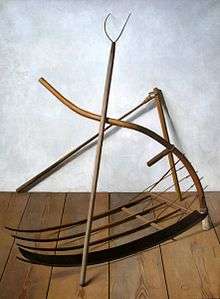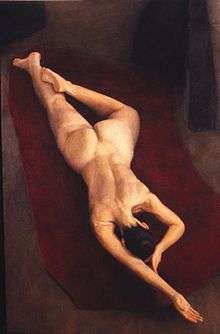Francis Cunningham (painter)
Francis Cunningham (born 1931) is an American figurative painter known for working across three genres – nude, landscape and still-life—and for being an influential teacher. He co-founded the New Brooklyn School of Life, Painting, Drawing & Sculpture, Inc. (1980–1983), and the New York Academy of Art (1983–1985).
Francis Cunningham | |
|---|---|
Artist Francis Cunningham | |
| Born | New York City, New York, USA |
| Alma mater | Harvard College |
| Occupation | Artist |
| Website | http://franciscunningham.com/ |
Biography
Born in New York City in 1931, Francis Cunningham grew up in Pittsfield, Massachusetts, where at the age of 16 he caught the attention of artist, Ben Shahn. He was further encouraged by his godmother, the Boston draftsman and painter Polly Thayer Starr. He graduated from Harvard College in 1953. After two years as a lieutenant in the U.S. Marine Corps, he attended the Art Students League of New York (1955–1959), where he studied drawing and anatomy with Robert Beverly Hale and painting with Edwin Dickinson. Cunningham, as with Dickinson and Dickinson's teacher, Charles Hawthorne, is part of an unconventional approach to realism and representation in American painting that began in 1914.[1][2] They share a way of looking and painting summarized in the term "color-spots" that Hawthorne invented, Dickinson practiced and taught, and that Cunningham developed and passed on as a technique.[3]
Cunningham began teaching at the City College of New York (1962–1965) and the Brooklyn Museum Art School (1962–1980). His Sunday high school scholarship class at BMAS came to be known for its nontraditional methods of figurative painting, observing directly from nature using a plumb-line and finder, and putting down on the flat surface of the canvas abstracted color-value notes. Students included Peter Colquhoun, Israel Hershberg, Richard Leto and Ephraim Rubenstein. "Francis Cunningham taught us all how to see," said Rubenstein. "He continually implored us to look at nature freshly 'like a new-born babe,' or like 'a man from Mars,' who had never laid eyes before on the things of this earth".[4] Cunningham taught at the Art Students League of New York (1980–1983). In 1980, he co-founded The New Brooklyn School of Life, Painting, Drawing & Sculpture, Inc., with the sculptor, Barney Hodes.[5] Together, they also co-founded, along with Stuart Pivar, The New York Academy of Art (1983–1985), which remains in operation as of 2020.
Career

Cunningham has had one-man shows in Washington, Chicago and New York, where he exhibited at the Waverly, Harry Salpeter and Hirschl & Adler galleries. He has had one-man shows in Stockholm and Copenhagen and has participated in group exhibitions extensively in the U.S. He is known for his landscapes of the Berkshires and his life-size anatomically functional paintings of nudes, a topic he explores in his book, “Unframing the Nude," to be published October 2013, in conjunction with his Century Masters Exhibition at The Century Association in NYC.
Cunningham currently maintains studios in NYC and Mill River, Massachusetts. His work includes landscape, still-life and the human figure, an unusual triumvirate of genres for contemporary figurative artists. He is the author of numerous articles, including "Color Spots, Form and Space," Linea, Art Students League of NY, vol. 4, No. 1, pp 10–22.
Cunningham's work belongs to private and public collections internationally. He is represented by Laurel Tracey Gallery in Red Bank, New Jersey.
Recognition and awards

Among other awards, Cunningham received the Artist Equity's Benjamin West Clinedist Medal (2003) for "the achievement of exceptional artistic merit", joining the company of Jacob Lawrence, Jack Levine and Isabel Bishop. He is the recipient of a Louis Comfort Tiffany Foundation Grant (1973). He was elected Academician of the National Academy of Design in 1994. He was a Fellow with the Bogliasco Foundation (1997). His work has been purchased by The Berkshire Museum in Pittsfield, Massachusetts.
Publications

Cunningham's book, "Unframing the Nude" (157 pages, illustrated) is forthcoming. He illustrated "Fundamentals of Roentgenology" by Dr. Lucy Frank Squire, Harvard University Press, 1964. He co-authored D.E. Gordon, "Polykleitos' Diadoumenos' Meadurement and Animation," The Art Quarterly, Summer 1962. For the Art Students League of NY's publication, he wrote "Color Spots, Form and Space," vol. 4, No. 1, and "The Nude: Mirror of Ourselves," vol. 3, No. 1. [6]
References
- Muhlberger, Richard (1999). Charles Webster Hawthorne: Paintings & Watercolors. Massachusetts: Chameleon Books. p. 108. ISBN 9780-295-97927-4.
- Dreishpoon, Douglas (2002). Edwin Dickinson: Dreams and Realities. New York: Hudson Hills Press. pp. 285. ISBN 1-55595-214-3.
- Hawthorne, Ethel Marion. (1960). Hawthorne on Painting. New York: Dover Publications, Inc. ISBN 048620653X.
- Rubenstein, Ephraim (2000). "Francis Cunningham: A selection of paintings from 1968 to the present". catalogue. a publication of the Francis Cunningham Art Trust.
- "Letters: Art and Reality". New York Magazine. May 13, 1996. p. 8. Retrieved May 12, 2020.
- Cunningham, Francis. "Color Spots, Form and Space". Art Students League of NY.
- "Francis Cunningham: A selection of paintings from 1968 to the present," a publication of the Francis Cunningham Art Trust
- "Color Spots, Form and Space," Linea, Art Students League of NY, vol. 4, No. 1, pp 10–22.
- "The Nude: Mirror of Ourselves," Linea, Arts Students League of NY, vol. 3, No. 1, pp 8–10
- "Nothing Left to Hide" by Maureen Mullarkey, New York Sun, http://www.nysun.com/arts/nothing-left-to-hide/41413
- "Drawings Lessons from the Great Masters" by Robert Beverly Hale (New York: Watson-Guptil Publications, 1964)